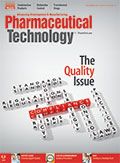Three Examples of Hypothetical ATPs
Three hypothetical analytical target profiles (ATPs) are provided, reflecting the current thinking of the the European Federation of Pharmaceutical Industries and Associations Analytical Lifecycle Management Team.
Editor's note: Click here for the full version of the article.
Three hypothetical ATPs are provided in the following tables, reflecting the current thinking of the EFPIA Analytical Lifecycle Management Team. The ATPs are preceded by some background information to support the selected performance criteria and rationale.
Example 1: Measurement of potency using a cell-based potency assay for a biological product
In addition to performing measurements of product CQAs, testing of potency is a unique feature of the release specification for biologics. Potency can be measured by in-vivo and in-vitro methodologies but is most often measured by in-vitro binding and cell-based bioassays.
Background and supporting information
A company is using a cell-based assay to measure the relative potency of a recombinant protein. The method is based on the mode of action of the drug and is used to measure the relative potency at release and during stability studies. The assay compares a test sample with a designated standard to provide a quantitative measurement of the bioactivity of the test relative to the standard. Prior to the development of a cell-based assay, the activity of the molecule was measured using a binding enzyme-linked immunosorbent assay (ELISA) method. This method will then be replaced by a cell-based assay that is more representative of the mode of action for Phase III studies. The proposed ATP could be applied to both the binding assay (e.g., ELISA) and the cell-based assay. One of the key aspects of the cell-based assay method is its specificity towards the molecule of interest and of the corresponding mechanism of action (i.e., signaling pathway).
During development, forced degradation studies highlighted some modifications in the structure of the molecule as confirmed by physicochemical assays. The cell-based assay to be developed should be able to detect a change in the dose response curve parameters and/or a shift in potency upon forced degradation.
All performance characteristics are linked to the reportable results generated using the method.

Example 2: Measurement of high molecular weight species (HMWS) in a biological product
For most biological products, HMWS in the form of dimers and/or oligomers constitute product related impurities, which need to be controlled. Consequently, the level of high molecular weight species in biomolecules need to be controlled as impurities at release and during stability studies of drug substance and drug product.
Background and supporting information
The method is used to quantify the size variants relatively, especially HMWS compared to the monomer species. The ATP was defined for early phase development but could also be applied to later phases, where the history of the product would allow adapting the method range. During stability and forced degradation testing, the company has generated data that establishes upper and lower limits for the observed HMWS changes under intended and accelerated storage conditions.

Example 3: Measurement of impurities in a small molecule drug product
Impurity content is a critical attribute of a drug product (see ICH Q6A as an example).
Background and supporting information
A company is using a purity method to monitor the stability of a small-molecule drug product. The method is used to quantify specified, known, and unknown degradation products in multiple quality control laboratories. Specified and known degradation products did not raise any specific safety concerns (e.g., genotoxicity) and limits, using the ICH Q3B thresholds, can be applied based on the maximum daily dose of the product not exceeding more than 1 g.
During stability and forced degradation testing, the company has generated data that indicates that one main degradation product (degradation product A) is formed under mild acidic conditions and could be present at levels up to 0.5% during the anticipated shelf life and storage condition. The shelf-life specification for degradation product A was not more than 0.5%.
Forced degradation studies also showed that basic conditions would form degradation product B. Degradation product B was not observed during accelerated and long-term stability studies.
Other degradation products were observed during the acidic and basic forced degradation studies, but at significantly lower levels. No additional degradation products or degradation mechanisms were observed under the other forced degradation conditions studied. The company decided to include impurity B along with any other unspecified degradation products with a specification of not more than 0.1% for each individual degradation product.
Although not a degradation product, impurity C is observed as a process related impurity regularly present in the API used to manufacture the product.
The company has provided sufficient supportive regulatory information and data that the following statements are considered true:
- ICH thresholds are met (relevant guidelines are fulfilled e.g., ICH Q3B; ICH M7);
- API losses can be recovered as degradation products (i.e., mass balance can be demonstrated);
- Degradation pathways are known, which enables the discriminatory requirements to be established for the stability indicating method;
- The origin and influencing factors for process related impurities is understood.
In the given example, method performance criteria could be set independent from the analytical principle chosen. However, a technology specific validation must be performed to demonstrate the suitability of the method (e.g., the precision/range requirement would translate into a linearity test and limit of quantitation test for a high-performance liquid chromatography method).

References
36. USP <1033> Biological Assay Validation, May 2017.
37. ICH, Q5C Quality of Biotechnological Products: Stability Testing of Biotechnological/Biological Products, Step 4 version, 30 November 1995.
